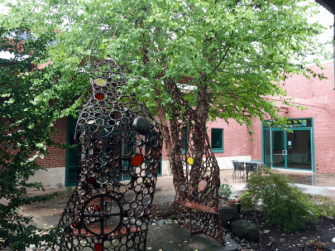By Tom Vander Ark and Victoria Bergsagel

is a K-12 public charter school in Phoenixville, 30 miles northwest of Philadelphia. Co-located with several businesses and educational service providers in a mixed-use development known as , it serves 1,060 K-12 students.
The school’s mission is to prepare a diverse cross-section of children for success as students, workers and citizens by providing them with a high-quality liberal arts, college preparatory education. 69´«Ă˝ come from 20 surrounding districts, about a fifth of whom live in or near poverty. The local school district retains about 30 percent of the state funding allotted to Renaissance and provides transportation services.
Incorporated and authorized by the local district in 1999, Renaissance opened as a K-8 school in 2000, added a high school the following year and graduated its first class in 2005. Last year the school graduated 75 students.
Academic Program
The school offers a longer-than-traditional school day and a school year of 195 days. 69´«Ă˝ receive a college prep academic program that includes art every day and an advisory period at all levels. In the lower school, advisories focus on character; in the upper grades on college preparation. The school also offers about four rotating AP courses and several dual enrollment opportunities.
Technology
Using tablets, laptops and desktops, CEO Gina Guarino Buli said, “We are quickly headed to 1:1.” Eleventh graders built an in increments on Google Classroom, which becomes a resource for the college application process.
Commencement Projects
69´«Ă˝ pick a topic during their freshman year and work on their project throughout high school. The project asks them to take what they have learned in the classroom and combine it with a personal passion to positively influence their world.
The process culminates in October of the senior year with a presentation to the school community. Presentations are early in the year so that seniors can include artifacts in their college applications. Parents and community members come to watch presentations and then eat a big buffet lunch together to celebrate student contributions.
Giving Back
We met two seniors on our visit who studied the nature of hunger in Norristown, which is 10 miles east of Phoenixville. They studied the issue, provided service, brokered food and bread donations, and developed a community garden utilized by over 100 families.
Learning that hunger affects the daily life of a surprising number of young people in their community, they reported gaining a better appreciation and compassion for others. The young man who spearheaded the garden project fell in love with horticulture and now plans to study biology in college.
We also met an Eagle Scout who designed, built and installed benches to help renovate a local park, making it more accessible and enjoyable for users of all ages and abilities.
Factory Renovation
While Renaissance Academy originally opened in 2000 on the campus, in 2008 it purchased part of a former industrial site, which over the last century served as a silk mill, carpet factory, plastics fabrication plant and most recently, a place where porcelain plumbing fixtures were made.

Converting 106,000 square feet of Franklin Commons into two distinct buildings for a lower and an upper school, they incorporated a library, arts studios, science labs and circulation spaces that provide for communal flex areas and collaborative activities.
The Design Process
In 2009 Renaissance engaged to conduct an educational visioning and programming study to help envision how to transform their newly-acquired space into a thriving learning environment. With AofA’s help the school’s design team developed guiding principles, several sketches, and a set of initial concepts, then issued a request for proposal (RFP) for a local architect. The Board of Trustees selected in 2010.
High ceilings, industrial fenestration and courtyards were par for the course as school leaders worked to ensure ample daylighting, community flex areas and whimsy were incorporated into the design.

Overcoming several challenges along the way, the school moved into its new home in 2015 where several historical features had been incorporated into the design, including some old factory fire doors that decorate the main hallway of the upper school.
Learning Real Estate Development on the Job
Renaissance was able to use construction bonds to finance its renovation. Encountering and overcoming several challenges along the way, its educators learned real estate development on the job.
Synergistic Site Amenities
Renaissance leverages partnerships with a number of tenants and contributes to the mixed-use educational campus. An example of the adaptive reuse of a former manufacturing complex, Franklin Commons hosts two churches, a gallery, and several businesses, including a preschool and daycare; music, martial arts and dance lessons; conferencing space; catering facilities; and satellite college programs. Nearby fields offer opportunities for environmental studies and extracurricular and sporting activities.
